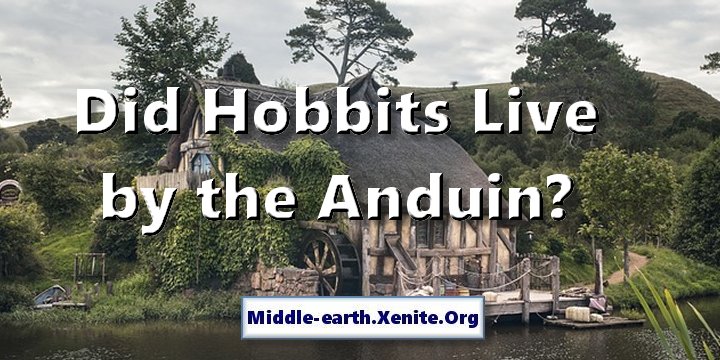
Q: Did Hobbits Live by the Anduin?
ANSWER: Yes, Hobbits did live by the Anduin river on several occasions across thousands of years. As I documented in the question and answer page for Where do Hobbits live in Middle-earth?, J.R.R. Tolkien wrote something about the history of Hobbits in the essay “Of Dwarves and Men”, which his son Christopher published in The Peoples of Middle-earth, the 12th volume of The History of Middle-earth. Here is the relevant passage:
…The language [that Hobbits] spoke when they entered Eriador was evidently adopted from the Men of the Vales of Anduin (related to the Atani, / in particular to those of the House of Bëor [> of the Houses of Hador and of Bëor]); and after their adoption of the Common Speech they retained many words of that origin. This indicates a close association with Big Folk; though the rapid adoption of the Common Speech in Eriador (59) shows Hobbits to have been specially adaptable in this respect. As does also the divergence of the Stoors, who had associated with Men of different sort before they came to the Shire.
The vague tradition preserved by the Hobbits of the Shire was that they had dwelt once in lands by a Great River, but long ago had left them, and found their way through or round high mountains, when they no longer felt at ease in their homes because of the multiplication of the Big Folk and of a shadow of fear that had fallen on the Forest. This evidently reflects the troubles of Gondor in the earlier part of the Third Age. The increase in Men was not the normal increase of those with whom they had lived in friendship, but the steady increase of invaders from the East, further south held in check by Gondor, but in the North beyond the bounds of the Kingdom harassing the older ‘Atanic’ inhabitants, and even in places occupying the Forest and coming through it into the Anduin valley. But the shadow of which the tradition spoke was not solely due to human invasion. Plainly the Hobbits had sensed, even before the Wizards and the Eldar had become fully aware of it, the awakening of Sauron and his occupation of Dol Guldur.(60)
The two notes referred to in this passage read thus:
59. When they entered Eriador (early in the second century of the Third Age) Men were still numerous there, both Numenoreans and other Men related to the Atani, beside remnants of Men of evil kinds, hostile to the Kings. But the Common Speech (of Numenorean origin) was in general use there, even after the decay of the North Kingdom. In Bilbo’s time great areas of Eriador were empty of Men. The desolation had begun in the Great Plague (soon after the Hobbits’ occupation of the Shire), and was hastened by the final fall and disappearance of the North Kingdom. In the Plague it would seem that the only Hobbit communities to survive were those in the far North-west at Bree and in the Shire. [The opening sentence of this note, placing the entry of the Hobbits into Eriador ‘early in the second century of the Third Age’, is plainly a casual error: presumably my father intended ‘millennium’ for ‘century’ (in Appendix B the date of the coming of the Harfoots is given under Third Age 1050, and that of the Fallohides and the Stoors under 1150).]
60. The invasions were no doubt also in great part due to Sauron; for the ‘Easterlings’ were mostly Men of cruel and evil kind, descendants of those who had served and worshipped Sauron before his overthrow at the end of the Second Age.
According to the Tale of Years, Appendix B in The Lord of the Rings the Hobbits lived in the Vales of Anduin until they migrated into Eriador. There they lived in relative peace until the wars between Angmar and the Dunadan realms led to the overthrow of Rhudaur. Many Stoors fled back over the mountains to the Vales of Anduin, settling near the Gladden Fields. They dwelt in that region for more than a thousand years, perhaps longer, before either dying out or moving away.
See also
When Did Hobbits become Divided into Fallohides, Stoors, and Harfoots?
What Is the Earliest Date Hobbits Could Have Settled in the Vales of Anduin?
Did Hobbits Ever Live in Tribes?
Where Did Hobbits Live in the First Age?
Did Hobbits Live by the Anduin?
# # #
Have you read our other Tolkien and Middle-earth Questions and Answers articles?
